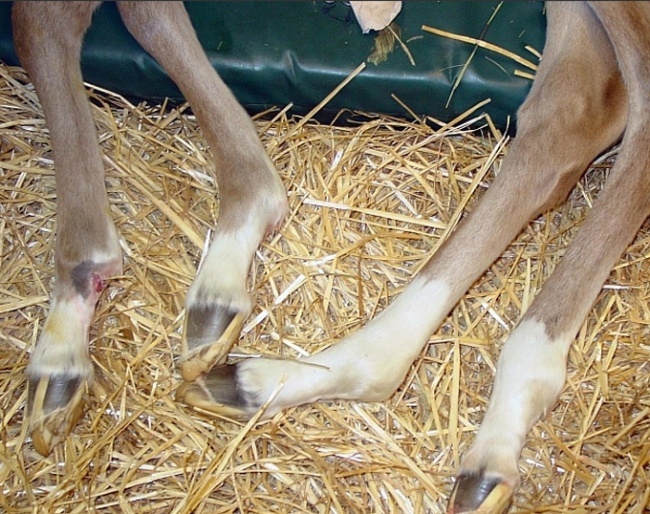
-- as reported in the WBFSH State of the Industry Report 2023
Originally known as Warmblood Fragile Foal Syndrome Type 1, is now known as Fragile Foal Syndrome (FFS), due to the conditions being present in other breeds.
FFS is an inherited defect of connective tissue and is characterised by hyperextensible, abnormally thin, fragile skin and mucous membranes that are subject to open lesions. This genetic disorder became public knowledge in 2018 in the USA. In 2021, published data indicated the identification of FFS in thoroughbreds, which is the first documented evidence of FFS outside of warmbloods. The repercussions of this research indicated a concern for this disease across different horse breeds and for wider genetic testing for breeding purposes.
Pathology
FFS is a monogenetic defect with autosomal recessive inheritance. It is caused by a recessive lethal missence point mutation in the procollagen-lysine, 2-oxoglutarate 5-deoxygenase1 (PLOD1) gene. This gene acts on collagen synthesis and causes reduction in collagen cross links. The frequency of FFS is relatively high in warmblood breeds and has a lower frequency in thoroughbreds. A recent study was found a few FFS carriers in Paint, Quarter and Hafliger horses. American Paint horse stallion offspring family consisted of 62.5% FFS carriers, demonstrating transmission of FFS.
Clinical presentation Affected horses may also have hyperextensible limb joints, floppy ears, accumulation of fluid, subcutaneous emphysema, hepatomas and premature birth. A majority of FFS homozygous foals are assumed lost by abortion during late gestation. Live-born affected foals show severe skin fragility, resulting in open lesions and joint hyper-elasticity, and often need to be euthanised shortly after birth. There are also friction and pressure points resulting in open lesions which often occur in-utero.
Genetic base
Fragile Foal Syndrome Type 1 is an autosomal recessive disease. Both males and females are equally affected, and two copies of the mutation are required to cause the disorder. Horses with one copy of the mutation do not show clinical signs but can transmit the mutation to their offspring. There is a DNA test available from submitted hair root samples to inform breeding decisions. In Germany, the largest sport horse population in Europe, it is estimated that between 10-20% of warmblood horses are heterozygous and asymptomatic FFS carriers. A similar percentage is described in warmblood sport horses in Brazil. Losses in warmblood breeding caused by FFS could be greater than previously assumed.
The positive effect of the FFS carriers is with movement-related traits. There is a plausibly that these carrier horses present a higher degree of joint laxity, as was assessed by comparing carrier horses with non-carrier horses. Non-jumping horses, most of which would be used for dressage showed walk seeming to be the most affected gait. Dressage horses are selected for high mobility with extreme locomotion patterns, this could possibly be a product of impaired collagen structure of FFS carriers.
Treatment
The disease is present at birth and affected newborn foals are euthanised shortly after birth due to the poor prognosis of this untreatable condition.
Related Links
WFFS in Thoroughbreds Prompts Renaming to Fragile Foal Syndrome
Dark Ronald xx, Not Origin Horse for Warmblood Fragile Foal Syndrome (WFFS)
Kareen Heineking-Schütte: "Two Cents About Warmblood Fragile Foal Syndrome"
Blue Hors Don Schufro Positive to WFFS
Breeder with Dead WFFS Foal Writes Open Letter to Danish Warmblood
U.S. Breeders and Stallion Owners on Alert for Warmblood Fragile Foal Syndrome